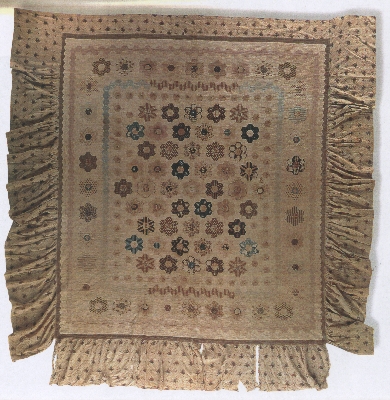Quilt No.861AG - Annette Gero

2280 x 2200mm
This quilt is attributed to Sarah Litherland, later Wall. It is now owned by Julie Silber of 'The Quilt Complex', Oakland, California and is on long term loan to Annette Gero.
"A Sarah Litherland was sentenced at Chester on 25 April 1797 to seven years transportation and arrived in NSW in 1801 aboard the Earl Cornwallis. She married a James Wall at St. John's Parramatta (Church of England) on 9 February 1807. James Wall was a resident of Hawkesbury. However, she eloped from him in 1809. Reported in the Sydney Gazette, 4th June, 1809, James Wall of Richmond Hill placed a notice cautioning the public against giving credit on his account to his wife Sarah Wall (formerly Litherland) as she had eloped from him and he would not be responsible for any debt she may contract.
The quilt is dated 1811. There is always the question of how she could afford the fabrics of chintzes and dimities in her quilt although they were readily obtainable in Sydney. Advertisements in the Sydney Gazette from 1803-1814 mention many sales and auctions of fabrics such as 'English cottons and dimity, palampores, colour cambric and English chintz', the kind of fabrics used in Sarah's quilt. However, was the quilt really made in Sydney? Allestry was a small town in the midlands of England at that time. Although a Sarah Wall lived in Sydney in 1811, we do not know whether this 'Sarah Wall' made the quilt. Unless there are descendants of the Richmond Hill Sarah Wall who have evidence that it was she who made the quilt we shall, unfortunately, never be able to definitely attribute this social history to the quilt."
[Annette Gero. Research by the Historic Houses Trust of NSW. Walsh, N., Index of References to Furniture and Furnishings in Advertisements in the Sydney Gazette 1803-1824, Historic Houses Trust of NSW, 1997]
Related Quilts:
1820 x 1680mm
1695 x 1390mm
1540 x 1150 mm.
cottons pieced in squares and rectangles within 2 frames, the inner border or frame of blue/green check material, then 2 rows of squares and rectangles, the outer frame of a grey and red geometric pattern and 2 rows of squares or rectangles. Backing of plain fabric. Machine stitched on a treadle machine.
2200 x 1100mm
1555 x 910mm






